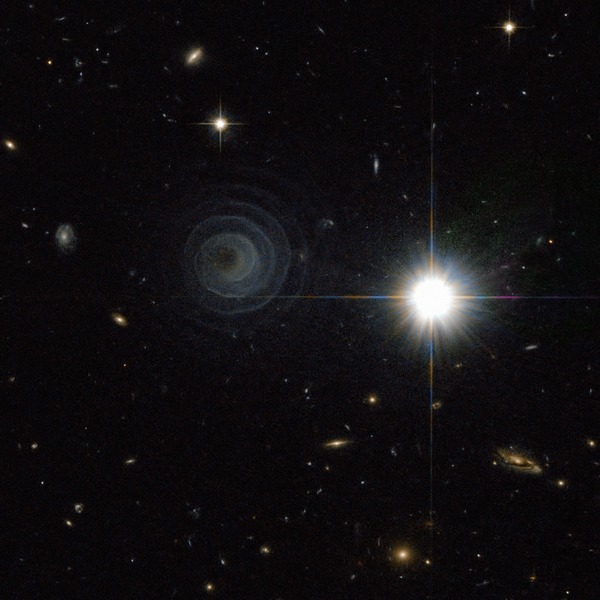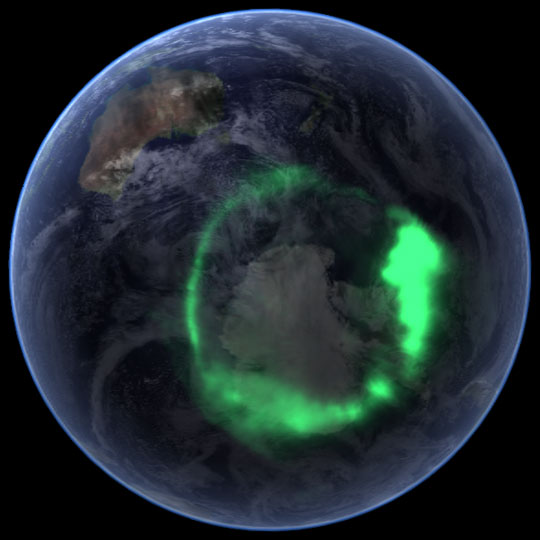Negative Dimensions
All the vortices that were discussed so far were vortices that belong to the positive dimensions. The transformation sequence consists of multiple cycles which are laid out as an expanding sine curve in the image below (you can click on the images below to get a bigger view). One single cycle goes back and forth between the positive and the negative side of the sequence. One half-cycle is positive dimensional, and is followed by another half-cycle that is negative dimensional. In the image below, everything that lies below the centerline is negative dimensional, while all that is located above the centerline is positive dimensional.
The characteristics of both of these sides of the sequence are different. For one part these two sides appear to be opposites, yet they also appear to have different properties that can not be considered opposites.
One of the differences between the positive side and the negative side is that on the negative side, matter is made entirely of plasma, this also includes the vortices that form within this side of the sequence, those vortices consist of plasma as well. On the positive side of the sequence we find all non-plasma matter, in the form of solids, liquids and gases. Although plasma is considered to be the fourth state of matter, here in the infinity theory it is treated a bit differently. We can still consider it to be the fourth state of matter, but it belongs to a different group than the first three states of matter.
| Positive Dimensions | Negative Dimensions |
| Non-plasma state matter | Plasma state matter |
| Movement goes forward in time | Movement goes backward in time |
| Matter has positive volume | Matter has a negative (inverted) volume |
| Vortices with a core connect to outward moving electromagnetic waves (perhaps when the vortex only has a core and no periphery) | Vortices with a core might connect to inward moving electromagnetic waves, but this has not been confirmed |
| Vortices with a periphery induce outward longitudinal movement of matter | Vortices with a periphery induce a continuous inward movement of matter |
The table above sums up some of the different characteristics of these opposite sides of the sequence. This is only a small list, a lot more needs to be understood about both of these opposites. For instance, Vortices in non-plasma state matter can be connected to outward moving electromagnetic waves. The vortices in plasma state matter should be able to be connected to some kind of opposite phenomenon. It is to be expected that plasma could be connected to inward moving electromagnetic waves. Waves that travel in the onefield from a distance towards the vortex. I do not know if that is so. It might be that plasma vortices do pull in waves, yet these are waves that can not be detected. Some of the characteristics of this table are discussed further ahead on this page. The property about time is discussed not on this page but on the page about time.
On the centerline itself, thus on the line between the positive and the negative side, we find the electromagnetic spectrum (again, you can click on the image for a bigger view). Each type of electromagnetic radiation belongs to one half-cycle. The electromagnetic spectrum is only located on this centerline, not in the sequence locations above or below the centerline. Peripheries of vortices above or below the centerline are not electromagnetic. Yet, if the vortex has a core, that core is electromagnetic. This is because the core has no volume. The further the distance from the centerline, the bigger the volume (not size) of vortices. All vortices that form exactly on the centerline, thus on the electromagnetic centerline, have no volume.
The first cycle is considered to be the first cycle that forms directly after the zero point, and ends at the infinity ring. The zero point is a unique point that distinguishes itself from all other EM crossing locations, because unlike the other EM crossing locations, this one has no volume and no size / radius. It is my expectation that the transformation sequence that lies at the left side of this point is in some ways opposite to the sequence that lies at the right side of this point (the left side is highlighted in gray in the image above). Yet so far I haven't been able to figure out what this exact difference is. I believe that the number of meridians for vortices on the left side of the zero point have a negative value, or that the number of meridians in vortices jumps from 0 to a very large, perhaps infinite (negative) number.
The ladders, spirals, bridges and tunnels that were discussed on the previous pages all belong to the first upper half-cycle. All these vortices are positioned somewhere between the zero point and the infinity ring. But the sequence does not end at these two EM crossing locations. Beyond these two locations we find other half-cycles that are located in the negative dimensions. And on the crossing locations itself lie the intermediate dimensions.
By now you already know how the sequence in the first half-cycle looks like. You know how the hyperkone connects to the zero point, and how the omega ladder (almost) connects to the infinity ring. These two vortices are the highest and lowest known in the first half-cycle. We are now going to go a step further and seek out what lies beyond those out most positions, and beyond those EM crossing locations. Much of the negative dimensional phenomena that lie beyond these EM crossing locations can be observed just as it was done with the positive dimensional phenomena. To explain to you the logic that reveals these dimensions, we need to take a look at the stars.
Star System
Of all the stars in the sky there is one star that has taught us more about all the other stars than any other object in the sky. And that star is the star that is closest to our home, the sun. The first thing we need to do is take a look at this big ball of plasma in the center of our solar system. In the picture below I've illustrated the sun in the middle of its disc spiral, the spiral that lies on the same plane on which all the planets rotate. This spiral is what shapes the heliospheric current sheet. To keep things simple I've illustrated the disc as a simple wire, at the macrocyclic scale level a disc would normally look more complex. What I also changed to keep things more simple is the scale of the disc, which would normally be a lot bigger relative to the size of the sun. This image is scaled down to simplify the illustration.

Now you have to ask yourself: why is our sun positioned in the middle of a disc spiral? Why is our sun located around the exact position where the spire, followed by the hyperkone hits the zero point? And thus where the vortex movement of the positive dimensions supposedly ends? Could it perhaps be that the sun is some kind of continuation of the sequence? Could it be that our sun is formed by dimensions that lie beyond the spire and the hyperkone?
To find out, we take a look at the different outer parts of what our sun is made of. I will shed a light on the sun's corona, the photosphere and the sun's magnetic field, and show how these parts of the sun relate to other parts of the sequence that we're already familiar with.
The Sun's Corona
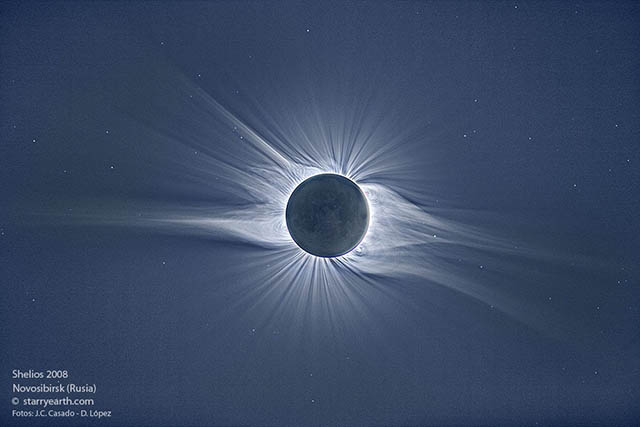
Image by J.C.Casado & D.López, under CC BY-NC-ND 3.0 license
This is an image of the sun's corona. A corona is a type of plasma "atmosphere" of the sun or other stars, that surrounds the space around the celestrial body to a distance of millions of kilometres. It is most easily seen during a total solar eclipse, but it can also be observed in a coronagraph. This plasma atmosphere extents further into space than the magnetic field lines of the sun. There is a way to find a connection between the shape of the corona, and the shape of the lowest dimensional vortices of the first half-cycle. In the shape of the corona, you should consider the two poles of the corona, and the remaining part of the corona, the circumference around those poles, as two separate shapes. If we assume those two different parts to be two different vortex types then the corona poles look like a vortex whose movement is perpendicular to that of two hyperkones, and the coronal circumference looks like a vortex whose movement is perpendicular to that of two opposing spires. Therefore the coronal pole, which is called the amplipole, is the negative dimensional antipode of the hyperkone, and the coronal circumference is the negative dimensional antipode of the spire. Because there are two spires opposing each other closely above the zero point, there should also be two coronal circumference opposing each other below the zero point, or, both vortices fuse into one vortex below the zero point. Those two pairs of vortices form the first two steps that come after the crossing the zero point from the positive dimensions into the negative dimensions.
THE SUN'S CORONA DOES NOT CONSIST OF ONE VORTEX TYPE, BUT TWO VORTEX TYPES. THE POLES OF THE CORONA ARE (ONE OR TWO) NEAR-EM SPIRALS, WHILE THE REMAINING PART OF THE CORONA THAT EXTENTS TO THE SIDES ARE (ONE OR TWO) LADDER VORTICES.
One of the characteristics of crossing the EM spectrum from the positive dimensions to the negative dimensions is that the movement of vortices becomes perpendicular to the same vortex movement on the opposite side of the sequence. This has to do with the vortices attaining a negative volume. The closer the vortex is located to the EM spectrum, the less its size in volume. On the EM spectrum itself the volume of the vortex is zero, although the size and radius can still vary greatly (the shape can consist of a line or surface with no volume). When crossing further into the opposite side of the sequence the volume of the vortex increases again, but this time its volume is negative (inverted). The type of matter that the periphery of a vortex forms changes from plasma to non-plasma and vise versa when going in the opposite direction.
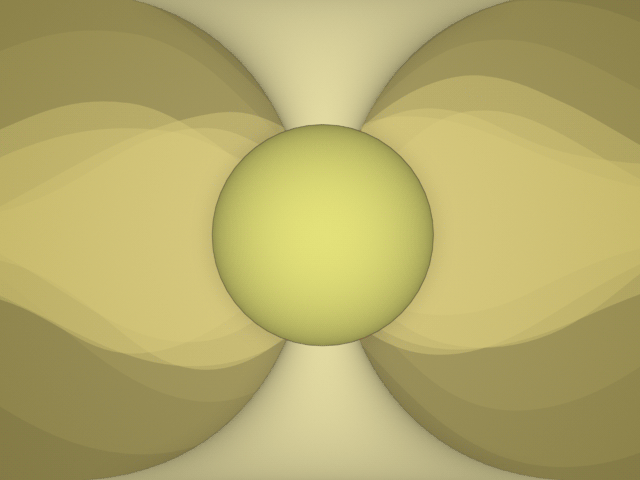
The two most visible elements of the sun are made of three different vortex types. The first visible element is thus the sun's corona that is for one part made of two opposing amplipoles, which are antipodes of the hyperkone, and for the other part made of the remaining region of the corona, the coronal circumference. The second visible element is the sun's photosphere, which is discussed below.
The Photosphere
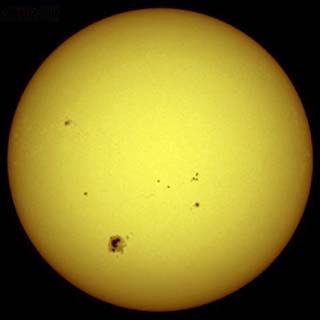 |
The photosphere is the outer most visible layer of the sun. The shape of the photosphere is that of a near-perfect hollow sphere, therefore we know that this vortex is an orb. Yet orbs can be one of several classes or combination of two or more classes, and we'd like to know which classification is correct.
The shape of the outer visible layer of the sun is indeed shaped by the movement of a vortex, and that vortex is a tunnel vortex. There are two reasons for this. First is that the photosphere is the part of the sun where most of the light comes from, therefore its location in the sequence must be close to the zero point. Its dimensionality must be close to 0.0D. A tunnel that connects two inward near-EM spirals can be located close the zero point, because it connects the two high ends of the spirals. Second reason is the location of the photosphere, which is located between the two amplipoles, thus located between the two near-EM spirals. The photosphere is what connects these two spirals.
THE PHOTOSPHERE IS THE TUNNEL VORTEX THAT CONNECTS THE TWO NEAR-EM SPIRALS, WHICH ARE THE POLES OF THE CORONA
But as you can observe, the two near-EM spirals of the corona do not look like spirals. There are no spiral arms. It is to be expected that any spiral that is a near-EM spiral will not completely look like a spiral. A near-EM spiral is only half a spiral, thus not a vortex that is fully formed. Furthermore, it is a very low dimensional vortex, close to the zero point. Therefore there is very little freedom om movement and thus hardly any potential to form a full spiral. Still these vortices do behave like spirals, and therefore are able to connect to a tunnel vortex.
The Sun's Magnetic Field
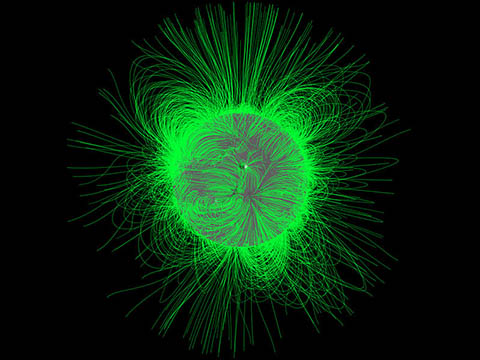
Image by NASA
The sun has a very strong and complex magnetic field in which the lines do not form a precise geometrical shape but look rather chaotic, entangled. It almost looks like the field lines are tied up in a knot at around the zero point or around the surface of a sphere. An unmorphed disc and an unmorphed spire only have core lines, an unmorphed disc or spire only consists of an electromagnetic movement. So when you see these magnetic field lines of the sun, entangled into a knot, around the zero point, you should start to sense that these magnetic field lines are perhaps the antipode of one of those two vortices.
Because the poles of the corona, the amplipoles, are likely to be the antipode of the hyperkone, and the remaining part of the corona is likely to be the antipode of the spire, it should mean that the most likely vortex to be the antipode of the sun's magnetic field is the disc. But one reason for doubt is its chaotic shape. This vortex does not look like a movement that is perpendicular to the direction of movement of the disc. Still it is the most likely candidate. The chaotic shape might be caused by the vortex wanting to form an orb, it wants to become spherical, yet it does not possess the movements to do so.
Binary Star System
A binary star system is a star system with two stars orbiting around each other. Binary stars are said to be companion stars of one another. It is thought that binary star systems are quite common in the universe, and may in fact be in the majority. The only way that we can determine the masses of stars is to study the orbital motions of binary stars. Calculations performed on these orbits allows us to calculate the masses of the stars from measures of their orbital periods, sizes and velocities. The closest star system, Alpha Centauri, is a binary star system, consisting of two closely orbiting sun-sized stars orbited in turn by a red dwarf.

Binary star systems form a plain piece of the puzzle in the transformation sequence. We already know how the stars are located on zero points, and that there are disc spirals around these stars. We also know that all spirals come in three varieties: single, double and binary. If we know about the existence of binary star systems all we need to do is fit the obvious pieces of the puzzle together and we come up with something that looks like the illustration above. Binary star systems are formed by binary disc spirals. It is sometimes hypothesized that binary stars can merge and form a single star, but this is not possible because two disc spirals can not merge into one. Just observe the swirls that you see on a the surface of a pond or the swirls behind an aircraft. The two spirals that make a binary spiral are never seen merging together. Only two swirls that rotate in the same direction can merge into one. The two stars at the centers of those disc spirals can not merge into one.
The good news here is that there is a Hubble photo of one particular binary star system, called LL Pegasi, that actually shows one of the two spirals that is part of the binary disc. Under normal circumstances, the disc spiral around the star is not visible to the naked eye. This is because a disc spiral is only made of a core movement, it has no periphery. Vortices that are made of only a core movement are not visible. The reason that this spiral is visible is because it is a highmorph disc, a disc that is partially morphed into a swirl. Astronomers believe that the presence of this spiral is somehow related to the fact that the star is dying, this could be true but it is still not certain. If we look at the direction in which the spiral rotates, we can conclude that the bridge should be somewhere at the lower side of these two stars in the picture.
Left - What created the strange spiral structure on the left? No one is sure, although it is likely related to a star in a binary star system entering the planetary nebula phase, when its outer atmosphere is ejected. The huge spiral spans about a third of a light year across and, winding four or five complete turns, has a regularity that is without precedent. Given the expansion rate of the spiral gas, a new layer must appear about every 800 years, a close match to the time it takes for the two stars to orbit each other. The star system that created it is most commonly known as LL Pegasi, but also AFGL 3068. The unusual structure itself has been cataloged as IRAS 23166+1655. The above image was taken in near-infrared light by the Hubble Space Telescope. Why the spiral glows is itself a mystery, with a leading hypothesis being illumination by light reflected from nearby stars [text by NASA].
On the right I placed a microscopic image of spiral formations in silicon in the ground. Note that the shape of these spirals is very similar to that of the spiral around the dying star. Both these examples are ascended discs. Also note that the silicon spirals both rotate in opposite direction. One is left-turning, the other is right-turning. So it could perhaps be that the silicon spirals are forming a binary spiral. In this example, the bridge should form somewhere at the top of the picture.
Fire

Image by NASA Lewis Research Center
Now, we know that the sun is a big ball of fire and by now we are starting to suspect that this big ball of fire is a negative dimensional vortex. If this is true then it could be that all fire is made out of negative dimensional vortices.
The fires that we experience here on earth never look spherical. We all know how fire looks like, so this is needless to say. A candle flame is stretched upward, it rises into the air. But when we ignite a flame in microgravity (near zero gravity) then that same flame looks spherical. This sphere could be the same vortex that forms one of the outer layers of the sun, like the solar atmosphere, the chromosphere or the heliosphere. This spherical flame can be been in the image above on the right, and also in the video below.
The corona is also a vortex that drives the movement of one type of fire. One source where we can observe this kind of vortex movement is from phosphorous. When you ignite a match on the side of match box, then the first couple of seconds of burning, the first flames that ignite within those first couple of seconds, that is a partial corona. That is the same vortex that shapes the sun's corona, yet on a different scale level, much smaller size. An example of this can be seen in the video below.
Linking an ignition flame from a match with the forces that give shape to the sun's corona allows us to understand both phenomena better. It allows us to add things that we know of one phenomenon to the other phenomenon, and vise versa. I am going to give you a simple definition that describes what fire is. Later on this page more pieces of the puzzle will fall into place.
FIRE = A VORTEX OF LOW NEGATIVE DIMENSIONS
PLASMA = MATTER THAT HAS A NEGATIVE (FLIPPED INSIDE OUT) VOLUME
Because fire is a vortex of negative dimensions it should produce an inward movement of non-plasma matter, which was one of the key properties of negative dimensional vortices which was mentioned in the table earlier on this page. This inward movement is oxygen. Fire needs to consume oxygen in able to exist. This consumption results in a continuous inward movement of matter, which is not visible to the naked eye.
THE INWARD MOVEMENT OF FIRE IS THE FLOW AND CONSUMPTION OF OXYGEN
Thus how can we know if this definition is correct? For that we need to look at a phenomenon that at first glance appears to be something completely different, but of which we know from its plasma state that the two are somehow related. And that something is called the aurora borealis.
Aurora Borealis
An aurora is a natural light display in the sky, particularly in the polar regions, that is believed to be caused by the collision of charged particles directed by the Earth's magnetic field. An aurora is usually observed at night and typically occurs in the ionosphere. It is also referred to as a polar aurora or, collectively, as polar lights. These phenomena are commonly visible between 60 and 72 degrees north and south latitudes, which place them in a ring just within the Arctic and Antarctic polar circles. Auroras do occur deeper inside the polar regions, but these are infrequent and often invisible to the naked eye. In northern latitudes, the effect is known as the aurora borealis (or the northern lights). Auroras can be spotted throughout the world and on other planets and are most visible closer to the poles [text from Wikipedia, slightly edited].
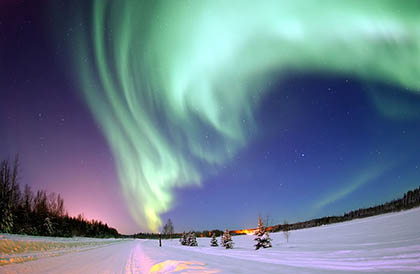 Image by Senior Airman Joshua Strang for United States Air Force |
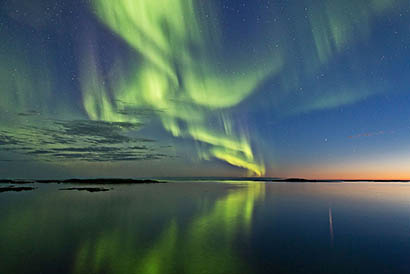 Image by Frank Olsen, under CC BY-SA 3.0 license |
So now that we know that there are plasma state vortices beyond the zero point, we could also suspect that there are plasma state vortices beyond the infinity ring. Both these regions of the sequence should be negative dimensional.
Problem is that I do not know for sure the location of the aurora in the transformation sequence. I first thought that the aurora is the first vortex that comes after the infinity ring. That would make the aurora the first vortex of the second half-cycle. This is because the aurora borealis is almost shaped like a ring. Yet it is not shaped as a ring, its shape is more annular. So my suspicion is that the aurora borealis connects to not the zero point, not the infinity ring, but another EM crossing location that is located beyond the infinity ring. That EM crossing location is annular shaped and thus for now we will call it the infinity belt. At this moment it seems more probable that the aurora is not located right beyond the infinity ring but one cycle higher instead, thus at the end of the fourth half-cycle, or perhaps two cycles higher, at the end of the sixth half-cycle. The EM crossing location between the second and the third cycle is probably the location of this belt (annular) shaped crossing location, but it might also be the located between the third and the fourth cycle.
It is not hard to tell that the aurora borealis is a very high dimensional vortex. First reason for this is its complex movement. The aurora borealis is very flexible and loosely moves like it has no restriction, its movement suggests that the vortex is frictionless. The aurora moves like a silk flag that waves in the wind. It should have many meridians to be able to move in such way. The aurora borealis also moves very slowly. You need to watch a time-lapse movie of an aurora like in the one below to be able to observe its movement. In the higher dimensions, time runs slower, thus vortex movement is slower. The aurora is perhaps one of the most complex vortices that we are able to observe.
The aurora borealis is a vortex within a half-cycle with an even number (2, 4, 6). Those half-cycles are negative dimensional, so the vortices in those cycles are made of plasma. The negative dimensions is also where we find many orbs. It is expected that a large percentage of all the vortices within that half-cycle are orbs, thus spherical vortices. Because of the location of the aurora borealis it is logical to assume that other vortices within that same half-cycle are hollow shaped orbs that form a part, or perhaps the entire earth's atmosphere. The vortices of the second half-cycle might form the layers of our planet. The vortices of the fourth half-cycle might form the earth's atmosphere. If we consider the altitude on which the aurora borealis is to be found, which is way above the earth's surface in the ionosphere, and link this with the fact that the ionosphere is made of plasma, then we can assume there to be a possibility that the ionosphere is one of the first vortices that is formed within the fourth half-cycle. What we know so far about the aurora enables us to formulate a simple definition of this phenomenon.
AURORA = A VORTEX OF HIGH NEGATIVE DIMENSIONS
Because the aurora is a negative dimensional vortex it should produce an inward movement of matter, which in this case is the solar wind, a stream of plasma released from the upper atmosphere of the sun. What class of vortex the aurora is is not sure. But a likely possibility is that the aurora is a near-EM vortex. Thus a vortex that spans only half a dimension level from its low end to it high end. I've decided to name the vortex type aurora as well. Yet when I use the name aurora borealis I'm referring to the atmospheric phenomenon at the poles of the earth or another planet. When I refer to any other phenomena of the same vortex type I only use the word aurora. There is also the aurora australis, which is the aurora that appears at the south pole, also called the southern lights. Its features are identical to the aurora borealis and its name too is what I only use for the atmospheric phenomenon, not for the vortex type.
Plasma State and Bright Colors
The next thing that falls into place is color. Both the aurora and fire show very vivid, bright colors. Fire can have all kinds of colors in the spectrum. Fire can be red, yellow, orange, blue, purple and some chemical fires can even produce a green fire. The aurora shows all these different colors as well, and they are bright colors that look like colors of a single wavelength, thus colors that are not blended. I do not know the reason yet as to why the negative dimensions show such bright colors, but it seems to be a characteristic that comes with negative dimensional vortices. Whenever you see something with bright, vivid colors, then it could be that you are looking at a negative dimensional vortex. This simple insight is very useful when you are looking at Hubble space telescope images. Whenever you see a vast display of colors of which each color is one single wavelength, you can expect that you are looking at something negative dimensional. One good example are all planetary nebula.

Photo montage by Ghislain Bonneau
The planetary nebula in the images above could be all kinds of vortices. We do not know the exact location of any of these vortices in the sequence, but these are all high negative dimensional vortices. They all consist of plasma.
So now we know that plasma is negative dimensional. This reveals to us that all sorts of lightning is negative dimensional. Lightning as well is a negative dimensional vortex. We also know that the solar wind is made of plasma, and so is St. Elmo's fire, the interstellar nebulae and the Io-Jupiter flux tube. This again widens our understanding of the world around us. One little discovery opens the path to the next.
Now lets go back to the other side of the sequence, and look at what vortices come directly after the zero point, but also look at what is on the zero point itself. If vortex movement follows the sequence over the positive side and moves in the direction of the zero point, then as the movement approaches the zero point the vortices get smaller and smaller. Suddenly, when the two spires, followed by the hyperkones, hit the zero point, light casts its rays in all directions. The light that we see coming from the sun is what comes directly from this EM crossing location, the zero point itself. And this phenomenon too is a vortex.
Light only consists of a core movement, electromagnetism. It does not form matter but it can be blocked by matter. Light is not just exceptional because it lies on a EM crossing location, it also behaves in ways that other vortices do not. One of the things is that its rays seem to stretch out in all direction to infinity. The movement appears to be evenly outward in all directions. But isn't that what low dimensional waves are supposed to do? Does this vortex take the same route as the wave it is connected to? The answer here is no. What we are looking at is actually the wave itself. In all other vortices we could not see the waves because they do not travel over our physical world. Only the part of the wave that intersects our physical world we can see, and that part is a vortex. But with light we can see the wave, meaning that this entire wave intersects our physical world. Thus this wave can be considered a vortex, it can also be considered to be a wave. Thus light is both a vortex and a wave, or in better words, the vortex IS the wave.
LIGHT = A NEAR ZERO DIMENSIONAL WAVE THAT FULLY INTERSECTS OUR PHYSICAL WORLD AND THEREBY ALSO MANIFESTS ITSELF AS A VORTEX
Both the aurora and the corona are made of plasma. The corona is very tight (low dimensional) while the aurora is very loose (high dimensional). Both the aurora and the corona have a chaotic shape. All the other vortices we looked at so far have a strong geometric / orderly shape. They all look like shapes that can be mapped with equations. The shape of the sun's corona does not look so orderly. In every photo you see of the sun's corona its shape looks different. It looks like the movement stretches out in all directions but it doesn't do this in straight lines like light does and doesn't do this in an orderly fashion. This non-orderly shape is something we also observe when we look at the aurora borealis. The aurora borealis looks like beautiful chaos. Its movement appears to be random without any recognizable strong shape. So it appears that all vortices that lie close behind an EM crossing location within the negative side of the sequence exhibit a chaotic shape.
A corona vortex is somewhat close to the same shape as the vortex that we call light. Light casts its rays equally in all directions in straight lines. The corona also casts its rays in all directions but not in evenly straight lines and not equally in all directions. The corona does have an upper and lower part, there seems to be some kind of axis running through the middle and its rays do not stretch out perfectly to infinity. The corona is a step between light and the orbs.

(The scales in the image above are incorrect. The corona should be a lot smaller than the two spires but then I would need to zoom and I wanted to keep the animation simple).
And so it appears that both the main shape of our sun and our earth is forged by spherical vortices. Furthermore, we know that the interior of these astronomical objects is divided into layers by their chemical or physical properties. It is very likely that these different layers with different properties are formed by different vortices. Spherical vortices must, like all the other vortices that we identified, connect to subsequent vortices of a different type. And when the vortex is spherical, there is not much choice then to go outward or inward to connect to another vortex, which is also spherical.
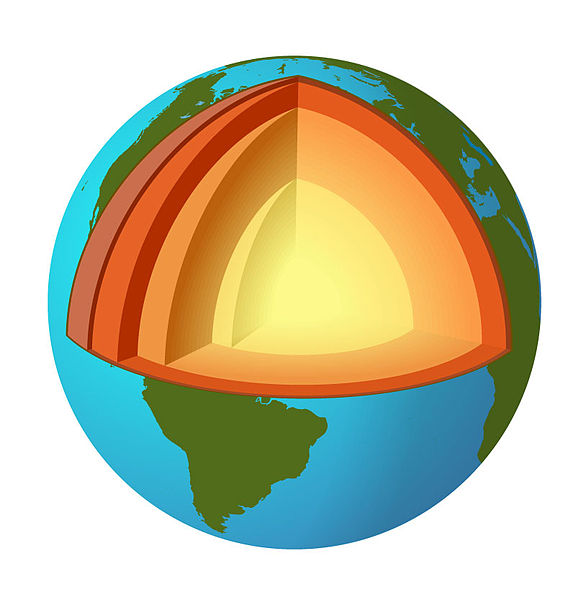 Image from Wikimedia, under CC BY-SA 3.0 license |
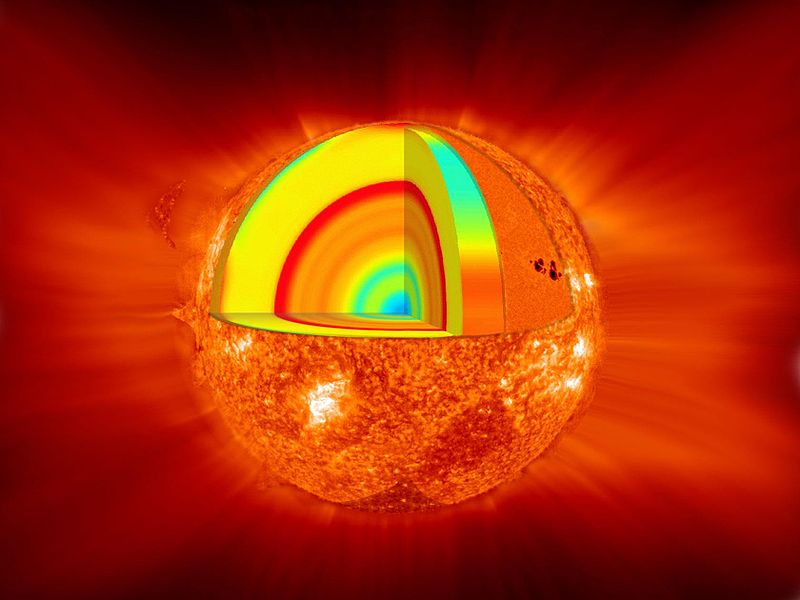 Image by NASA |
This all suggests that there are more types of spherical vortices, of which so far only the photosphere has been identified to the extent that we know its probably location within the transformation sequence. I already said that I use a special name for these vortices, and that name is 'orb'. There is not much we know about the orbs, but there are a few things that we do know about them and that you will get to read about on the next page, which is a page completely dedicated to these orbs.
| All content on this site that is authored by Peter.A.Venis is licensed under the Creative Commons CC BY 4.0 license, unless otherwise mentioned. Most pages on this website also include material from other authors, under different licenses. Both the author's names and the licenses are mentioned in the file names whenever this information is known and can be provided. The presence of work from other authors on this website does not necessarily imply that those authors endorse the contents of this website. |
| A word that is often used on this website is the word 'vortex'. Many sources describe a vortex as a movement in a fluid that has a rotational flow. Yet many of the vortices that I describe on this website do not show a visible rotational flow. I took the liberty of using the word vortex for describing a phenomenon that had not been understood before, one that links together rotational and non-rotational movements. Even a movement in a straight line can in some cases be categorized as a vortex, if it is known that that movement is created by certain identical conditions. So keep in mind that the word 'vortex', within the context of the infinity-theory, has not the exact same meaning as other sources describe. |







